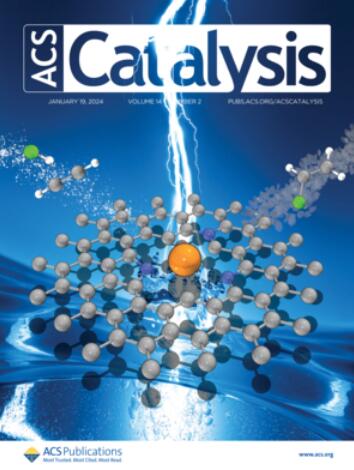铁基催化剂重组促进CO2加氢生成C2+烯烃的研究
IF 11.3
1区 化学
Q1 CHEMISTRY, PHYSICAL
引用次数: 0
摘要
在CO2加氢过程中,邻近的N原子可以调节铁基催化剂活性中心的电子结构。这项工作为Fe4N活性中心与碳链生长途径之间的关系提供了机制见解。Na/Fe4N催化剂对CO和C2+烯烃具有较高的选择性,烯烃-石蜡(O/P)比较高,对CH4选择性较低。通过实验证据和理论计算相结合,我们确定了在Fe4N和Fe5C2催化剂上碳化物介导的途径比CO插入机制更有利。此外,Na/Fe4N(110)表面C-C耦合的能垒(0.62 eV)低于Na/Fe5C2(11-2)表面的能垒(0.98 eV)。对比分析表明,Na/Fe4N的加氢能力较Na/Fe5C2弱,而CHx中间体和非解离吸附CO种类较多。这些在铁基催化体系中增强C-C耦合的基本见解有望为合理设计用于二氧化碳利用的高性能催化剂提供指导。本文章由计算机程序翻译,如有差异,请以英文原文为准。

N Restructuring of Iron-Based Catalysts Boosting the Formation of C2+ Olefins from CO2 Hydrogenation
The electronic structure of the active centers of an iron-based catalyst can be modulated by neighboring N atoms in the hydrogenation of CO2. This work provides mechanistic insights into the relationship between the Fe4N active centers and carbon chain growth pathways. The Na/Fe4N catalyst exhibits higher selectivity toward CO and C2+ olefins with a higher olefin-to-paraffin (O/P) ratio and lower selectivity toward CH4. Through combined experimental evidence and theoretical calculations, we establish that the carbide-mediated pathway is more favored than the CO insertion mechanism on both the Fe4N and Fe5C2 catalysts. Furthermore, the energy barrier for C–C coupling on the Na/Fe4N(110) surface (0.62 eV) is lower than that on Na/Fe5C2(11–2) (0.98 eV). Comparative analysis reveals that Na/Fe4N has weaker hydrogenation capability compared to Na/Fe5C2 while possessing more CHx intermediates and nondissociatively adsorbed CO species. These fundamental insights into enhancing C–C coupling in iron-based catalytic systems are expected to offer guidance for the rational design of high-performance catalysts for CO2 utilization.
求助全文
通过发布文献求助,成功后即可免费获取论文全文。
去求助
来源期刊

ACS Catalysis
CHEMISTRY, PHYSICAL-
CiteScore
20.80
自引率
6.20%
发文量
1253
审稿时长
1.5 months
期刊介绍:
ACS Catalysis is an esteemed journal that publishes original research in the fields of heterogeneous catalysis, molecular catalysis, and biocatalysis. It offers broad coverage across diverse areas such as life sciences, organometallics and synthesis, photochemistry and electrochemistry, drug discovery and synthesis, materials science, environmental protection, polymer discovery and synthesis, and energy and fuels.
The scope of the journal is to showcase innovative work in various aspects of catalysis. This includes new reactions and novel synthetic approaches utilizing known catalysts, the discovery or modification of new catalysts, elucidation of catalytic mechanisms through cutting-edge investigations, practical enhancements of existing processes, as well as conceptual advances in the field. Contributions to ACS Catalysis can encompass both experimental and theoretical research focused on catalytic molecules, macromolecules, and materials that exhibit catalytic turnover.
 求助内容:
求助内容: 应助结果提醒方式:
应助结果提醒方式:


